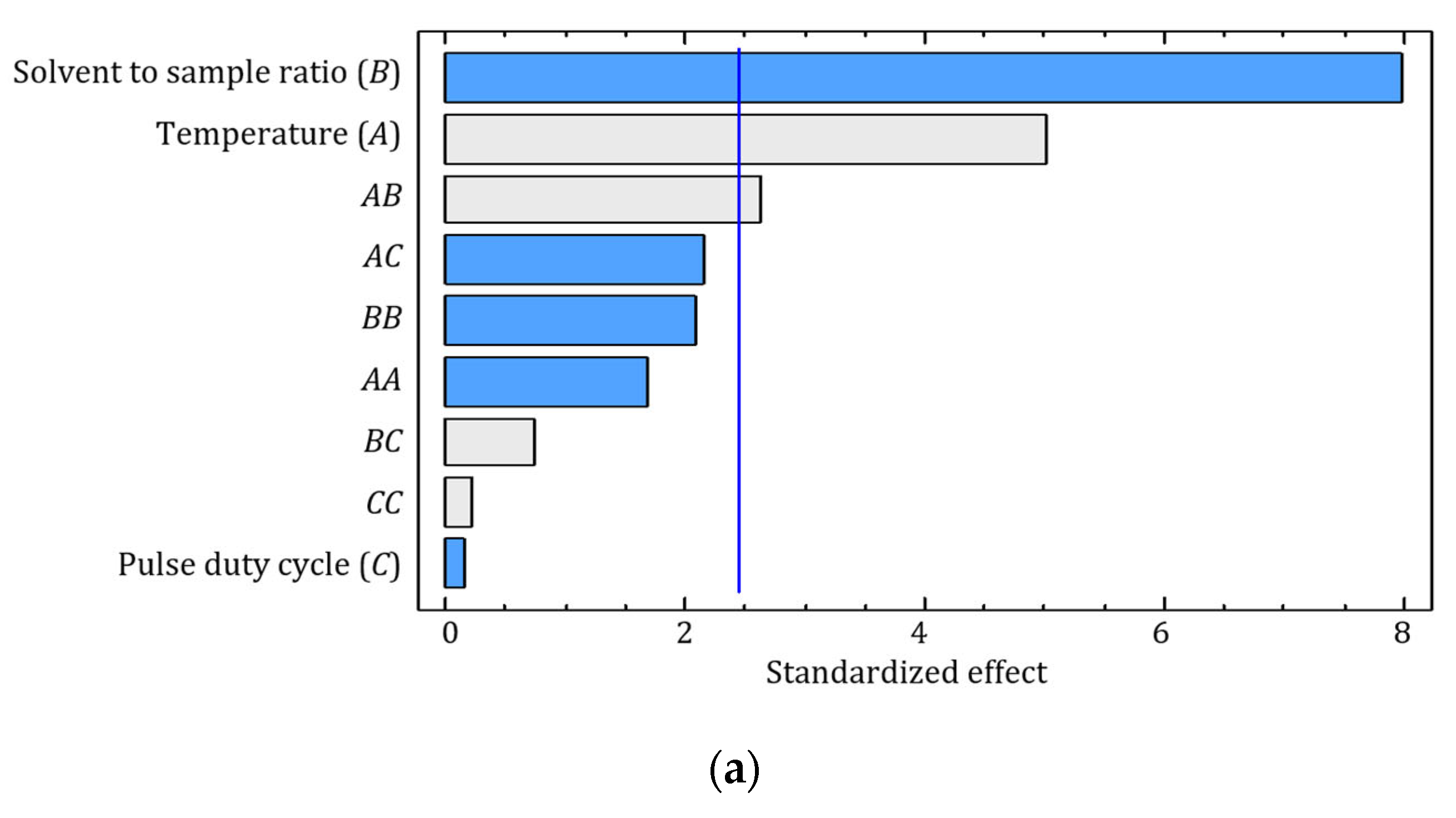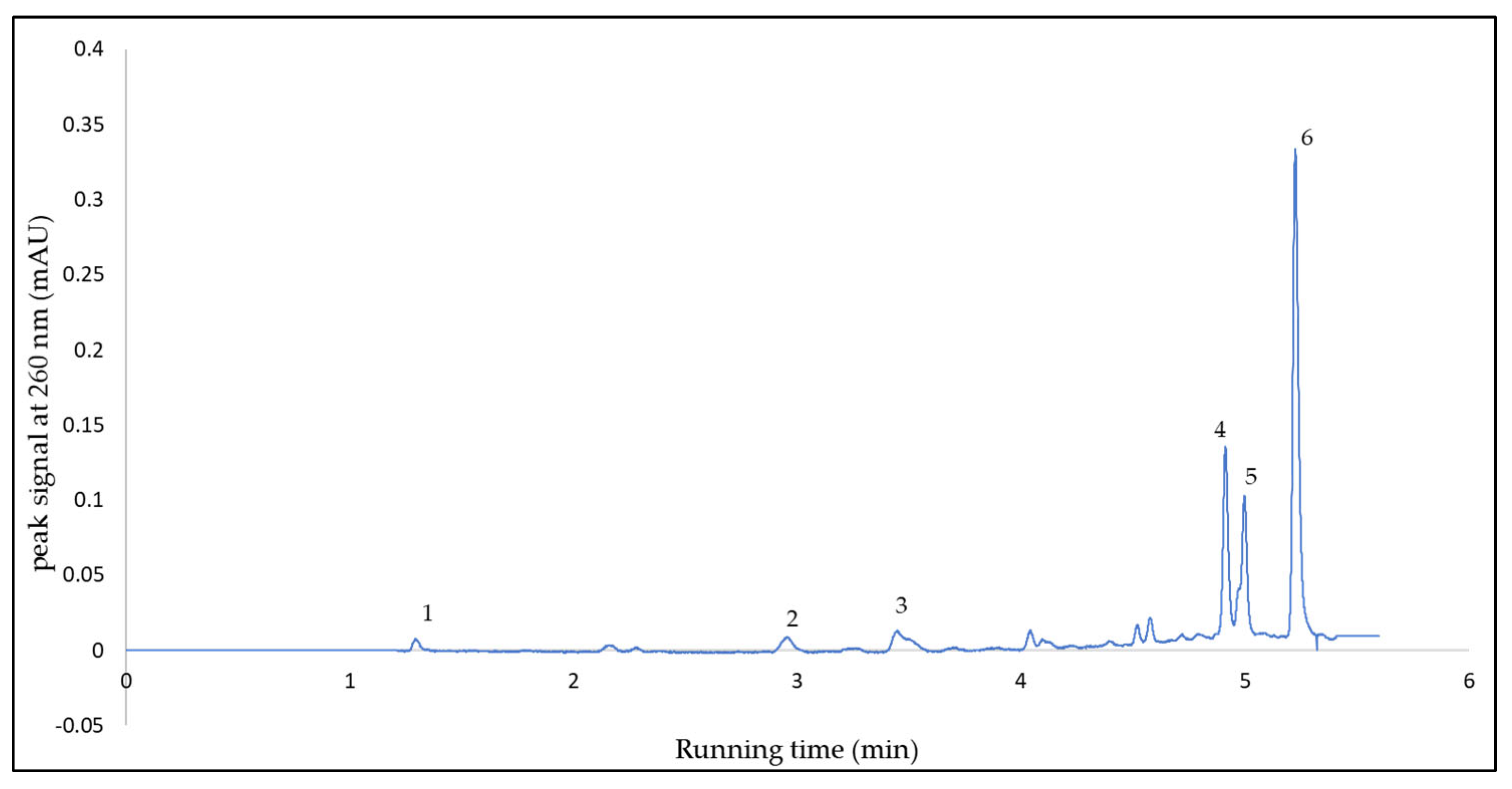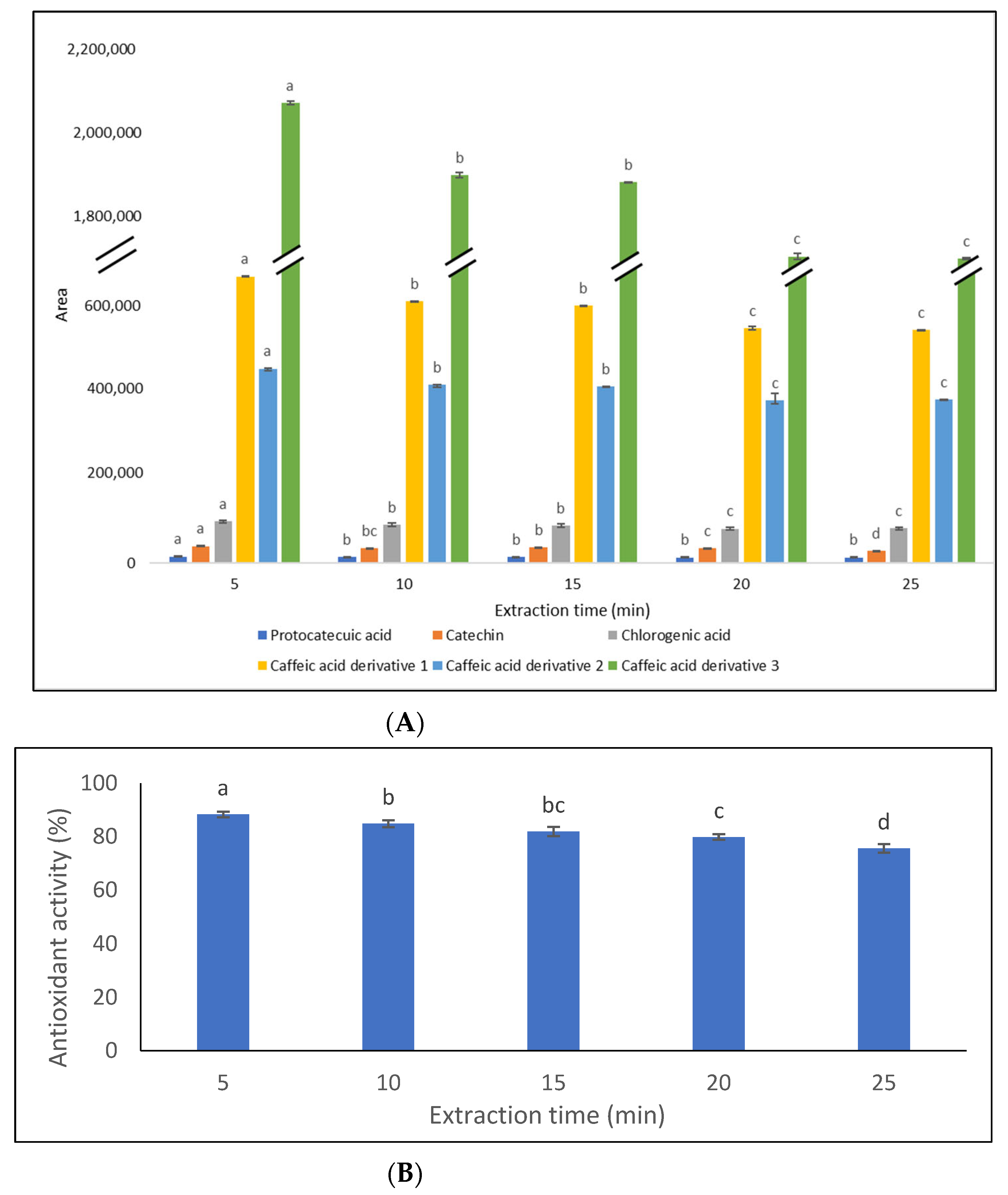Optimization of Ultrasound-Assisted Extraction from Young Coconut Mesocarp in the Rapid Extraction of Phenolic Compounds and Antioxidant Activity
Abstract
:1. Introduction
2. Materials and Methods
2.1. Chemicals
2.2. Plant Material
2.3. Extraction of Phenolic Compounds
2.4. Analysis of Total Phenolic Content (TPC)
2.5. DPPH Radical Scavenging Activity (DPPH-RSA)
2.6. Analysis of Individual Phenolic Compounds
2.7. Experimental Design
2.8. Process Precision Evaluation
2.9. Statistical Analysis
3. Results
3.1. Effects of Extraction Variables
3.2. Polynomial Models for the Response Surface
3.3. Multi-Response Optimization
3.4. Identification of Phenolic Compounds
3.5. Kinetic Study
3.6. Precisions of UAE Process
4. Conclusions
Author Contributions
Funding
Institutional Review Board Statement
Informed Consent Statement
Data Availability Statement
Acknowledgments
Conflicts of Interest
References
- DebMandal, M.; Mandal, S. Coconut (Cocos nucifera L.: Arecaceae): In Health Promotion and Disease Prevention. Asian Pac. J. Trop. Med. 2011, 4, 241–247. [Google Scholar] [CrossRef] [Green Version]
- FAOSTAT. Available online: https://www.fao.org/faostat/en/#data/QCL (accessed on 27 October 2022).
- Chakraborty, M.; Mitra, A. The Antioxidant and Antimicrobial Properties of the Methanolic Extract from Cocos nucifera Mesocarp. Food Chem. 2008, 107, 994–999. [Google Scholar] [CrossRef]
- Elsbaey, M.; Abdel, B.F.M. Coconut Waste as a Potential Source for Cytotoxic and Antioxidant Compounds. Int. J. Pharmacogn. Phytochem. Res. 2017, 9, 1288–1292. [Google Scholar] [CrossRef] [Green Version]
- Kibria, A.A.; Kamrunnessa, M.; Rahman, M. Extraction And Evaluation Of Phytochemicals From Green Coconut (Cocos nucifera) Shell. Malays. J. Halal Res. (MJHR) 2018, 1, 19–22. [Google Scholar] [CrossRef]
- Onyechi, O.; Elijah, P.; Nkechi, J. Phytochemical Analysis of Cocos nucifera L. J. Pharm. Res. 2010, 3, 280–286. [Google Scholar]
- Silva, R.R.; Oliveira, D.; Fontes, H.R.; Alviano, C.S.; Fernandes, P.D.; Alviano, D.S. Anti-inflammatory, antioxidant, and antimicrobial activities of Cocos nucifera var. typica. BMC Complement. Altern. Med. 2013, 13, 107. [Google Scholar] [CrossRef] [Green Version]
- Valadez-carmona, L.; Cortez-Garcia, R.M.; Plazola-Jacinto, C.P.; Ortiz-Moreno, A.; Necoechea-Mondrago, H. Effect of Microwave Drying and Oven Drying on the Water Activity, Color, Phenolic Compounds Content and Antioxidant Activity of Coconut Husk (Cocos nucifera L.). J. Food Sci. Technol. 2016, 53, 3495–3501. [Google Scholar] [CrossRef] [Green Version]
- Leliana, L.; Setyaningsih, W.; Palma, M.; Supriyadi, S.; Santoso, U. Antioxidant Activity of Aqueous and Ethanolic Extracts of Coconut (Cocos nucifera) Fruit By-Products. Agronomy 2022, 12, 1102. [Google Scholar] [CrossRef]
- Emojevwe, V. Hypoglycaemic Effects of Cocos nucifera (Coconut) Husk Extract on Alloxan Induced Female Diabetic Wistar Rats. Cont. J. Med. Res. 2012, 6, 5–10. [Google Scholar] [CrossRef]
- Bo, J.; Muyiwa, A. Effects of Alkaloids of Cocos nucifera Husk Fibre on Cardiovasular Disease Indices in Albino Mice. J. Card. Pharmacol. 2019, 8, 1000253. [Google Scholar] [CrossRef]
- Das, R.R.; Rahman, M.A.; Al-Araby, S.Q.; Islam, M.S.; Rashid, M.M.; Babteen, N.A.; Alnajeebi, A.M.; Alharbi, H.F.H.; Jeandet, P.; Rafi, M.K.J.; et al. The Antioxidative Role of Natural Compounds from a Green Coconut Mesocarp Undeniably Contributes to Control Diabetic Complications as Evidenced by the Associated Genes and Biochemical Indexes. Oxidative Med. Cell Longev. 2021, 2021, 9711176. [Google Scholar] [CrossRef]
- Javier Cortés-Rivera, H.; Javier Blancas-Benitez, F.; del Carmen Romero-Islas, L.; Gutiérrez-Martinez, P.; Ramón González-Estrada, R. In Vitro Evaluation of Residues of Coconut (Cocos nucifera L.) Aqueous Extracts, against the Fungus Penicillium Italicum. Emir. J. Food Agric. 2019, 31, 613–617. [Google Scholar] [CrossRef]
- Buamard, N.; Benjakul, S. Improvement of Gel Properties of Sardine (Sardinella albella) Surimi Using Coconut Husk Extracts. Food Hydrocoll. 2015, 51, 146–155. [Google Scholar] [CrossRef]
- Javier Cortés-Rivera, H.; Javier Blancas-Benitez, F.; del Carmen Romero-Islas, L.; Gutiérrez-Martinez, P.; Ramón González-Estrada, R. Effect of Ethanolic Coconut Husk Extract and Pre-Emulsification on Properties and Stability of Surimi Gel Fortified with Seabass Oil during Refrigerated Storage. LWT—Food Sci. Technol. 2019, 108, 160–167. [Google Scholar] [CrossRef]
- Azaroual, L.; Liazid, A.; el Mansouri, F.; Brigui, J.; Ruíz-Rodriguez, A.; Barbero, G.F.; Palma, M. Optimization of the Microwave-Assisted Extraction of Simple Phenolic Compounds from Grape Skins and Seeds. Agronomy 2021, 11, 1527. [Google Scholar] [CrossRef]
- Boulekbache-makhlouf, L.; Medouni, L.; Medouni-adrar, S.; Arkoub, L.; Madani, K. Effect of Solvents Extraction on Phenolic Content and Antioxidant Activity of the Byproduct of Eggplant. Ind. Crops Prod. 2013, 49, 668–674. [Google Scholar] [CrossRef]
- Derakhshan, Z.; Ferrante, M.; Tadi, M.; Ansari, F.; Heydari, A.; Sadat, M.; Oliveri, G.; Khalili, E. Antioxidant Activity and Total Phenolic Content of Ethanolic Extract of Pomegranate Peels, Juice and Seeds. Food Chem. Toxicol. 2018, 114, 108–111. [Google Scholar] [CrossRef]
- Tabaraki, R.; Heidarizadi, E.; Benvidi, A. Optimization of Ultrasonic-Assisted Extraction of Pomegranate (Punica granatum L.) Peel Antioxidants by Response Surface Methodology. Sep. Purif. Technol. 2012, 98, 16–23. [Google Scholar] [CrossRef]
- José Aliaño González, M.; Carrera, C.; Barbero, G.F.; Palma, M. A Comparison Study between Ultrasound–Assisted and Enzyme–Assisted Extraction of Anthocyanins from Blackcurrant (Ribes nigrum L.). Food Chem. X 2022, 13, 100192. [Google Scholar] [CrossRef] [PubMed]
- Espada-bellido, E.; Ferreiro-gonzález, M.; Carrera, C.; Palma, M.; Barroso, C.G.; Barbero, G.F. Optimization of the Ultrasound-Assisted Extraction of Anthocyanins and Total Phenolic Compounds in Mulberry (Morus nigra) Pulp. Food Chem. 2017, 219, 23–32. [Google Scholar] [CrossRef]
- Singla, R.K.; Jaiswal, N.; Bhat, V.; Jagani, H. Antioxidant & Antimicrobial Activities of Cocos nucifera Linn. (Arecaceae) Endocarp Extracts. Indo Glob. J. Pharm. Sci. 2011, 4, 354–361. [Google Scholar]
- Thebo, N.K.; Simair, A.A.; Mangrio, G.S.; Ansari, K.A.; Bhutto, A.A.; Lu, C.; Sheikh, W.A. Antifungal Potential and Antioxidant Efficacy in the Shell Extract of Cocos nucifera (L.) (Arecaceae) against Phatogenic Dermal Mycosis. Medicines 2016, 3, 12. [Google Scholar] [CrossRef] [PubMed]
- Esquenazi, D.; Wigg, M.D.; Miranda, M.M.F.S.; Rodrigues, H.M.; Tostes, J.B.F.; Rozental, S.; Antonio, J.R.; Alviano, C.S. Antimicrobial and Antiviral Activities of Polyphenolics from Cocos nucifera Linn. (Palmae) Husk Fiber Extract. Res. Microbiol. 2002, 153, 647–652. [Google Scholar] [CrossRef]
- Heenataj, B.; Kushmitha, V.; Babu, N.G.R.; Seethalakshmi, I. Antioxidants and Cytotoxicity Analysis of Coconut Husk Extract. Int. J. Eng. Res. Manag. (IJERM) 2017, 4, 5–9. [Google Scholar]
- Chemat, F.; Rombaut, N.; Sicaire, A.; Meullemiestre, A.; Abert-vian, M. Ultrasound Assisted Extraction of Food and Natural Products. Mechanisms, Techniques, Combinations, Protocols and Applications. A Review. Ultrason. Sonochem. 2017, 34, 540–560. [Google Scholar] [CrossRef]
- Susanti, E.P.; Rohman, A.; Setyaningsih, W. Dual Response Optimization of Ultrasound-Assisted Oil Extraction from Red Fruit (Pandanus conoideus): Recovery and Total Phenolic Compounds. Agronomy 2022, 12, 523. [Google Scholar] [CrossRef]
- Aliaño-González, M.J.; Barea-Sepúlveda, M.; Espada-Bellido, E.; Ferreiro-González, M.; López-Castillo, J.G.; Palma, M.; Barbero, G.F.; Carrera, C. Ultrasound-Assisted Extraction of Total Phenolic Compounds and Antioxidant Activity in Mushrooms. Agronomy 2022, 12, 1812. [Google Scholar] [CrossRef]
- Khan, M.K.; Abert-vian, M.; Dangles, O.; Chemat, F. Ultrasound-Assisted Extraction of Polyphenols (Flavanone glycosides) from Orange (Citrus sinensis L.) Peel. Food Chem. 2010, 119, 851–858. [Google Scholar] [CrossRef]
- Jelena, Ž.; Katarina, Š.; Jankovi, T.; Nada, Ć. Separation and Puri Fi Cation Technology Optimization of Ultrasound-Assisted Extraction of Polyphenolic Compounds from Pomegranate Peel Using Response Surface Methodology. Sep. Purif. Technol. 2018, 194, 40–47. [Google Scholar] [CrossRef]
- Dranca, F.; Oroian, M. Optimization of Ultrasound-Assisted Extraction of Total Monomeric Anthocyanin (TMA) and Total Phenolic Content (TPC) from Eggplant (Solanum melongena L.) Peel. Ultrason. Sonochem. 2016, 31, 637–646. [Google Scholar] [CrossRef]
- Ismail, B.B.; Guo, M.; Pu, Y.; Wang, W.; Ye, X. Valorisation of Baobab (Adansonia digitata) Seeds by Ultrasound Assisted Extraction of Polyphenolics. Optimisation and Comparison with Conventional Methods. Ultrason. Sonochem. 2019, 52, 257–267. [Google Scholar] [CrossRef]
- Luo, X.; Cui, J.; Zhang, H.; Duan, Y.; Zhang, D.; Cai, M.; Chen, G. Ultrasound Assisted Extraction of Polyphenolic Compounds from Red Sorghum (Sorghum bicolor L.) Bran and Their Biological Activities and Polyphenolic Compositions. Ind. Crops Prod. 2018, 112, 296–304. [Google Scholar] [CrossRef]
- Al-Dhabi, N.A.; Ponmurugan, K.; Maran Jeganathan, P. Development and Validation of Ultrasound-Assisted Solid-Liquid Extraction of Phenolic Compounds from Waste Spent Coffee Grounds. Ultrason. Sonochem. 2017, 34, 206–213. [Google Scholar] [CrossRef]
- Singleton, V.L.; Orthofer, R.; Lamuela-Raventós, R.M. Analysis of Total Phenols and Other Oxidation Substrates and Antioxidants by Means of Folin-Ciocalteu Reagent. Methods Enzymol. 1999, 299, 152–178. [Google Scholar]
- Brand-Williams, W.; Cuvelier, M.E.; Berset, C. Use of a Free Radical Method to Evaluate Antioxidant Activity. Lebensm.-Wiss. Technol. 1995, 28, 25–30. [Google Scholar] [CrossRef]
- Hassan, R.M.; Hassan, N.A.; Fhadhila, A.; Yusoff, A.M. Ultrasound-Assisted Extraction of Natural Colourant from Husk of Cocos nucifera: A Comparison with Agitated-Bed Extraction. Pertanika J. Sci. Technol. 2018, 26, 1039–1052. [Google Scholar]
- Dzah, C.S.; Duan, Y.; Zhang, H.; Wen, C.; Zhang, J.; Chen, G.; Ma, H. The Effects of Ultrasound Assisted Extraction on Yield, Antioxidant, Anticancer and Antimicrobial Activity of Polyphenol Extracts: A Review. Food Biosci. 2020, 35, 100547. [Google Scholar] [CrossRef]
- Kumar, K.; Srivastav, S.; Sharanagat, V.S. Ultrasound Assisted Extraction (UAE) of Bioactive Compounds from Fruit and Vegetable Processing by-Products: A Review. Ultrason. Sonochem. 2021, 70, 105325. [Google Scholar] [CrossRef]
- Goldsmith, C.D.; Vuong, Q.V.; Stathopoulos, C.E.; Roach, P.D.; Scarlett, C.J. Ultrasound Increases the Aqueous Extraction of Phenolic Compounds with High Antioxidant Activity from Olive Pomace. LWT—Food Sci. Technol. 2018, 89, 284–290. [Google Scholar] [CrossRef] [Green Version]
- Wang, L.; Pan, X.; Jiang, L.; Chu, Y.; Gao, S.; Jiang, X.; Zhang, Y.; Chen, Y.; Luo, S.; Peng, C. The Biological Activity Mechanism of Chlorogenic Acid and Its Applications in Food Industry: A Review. Front. Nutr. 2022, 9, 943911. [Google Scholar] [CrossRef]
- Sánchez-Alonso, I.; Careche, M.; Moreno, P.; González, M.J.; Medina, I. Testing Caffeic Acid as a Natural Antioxidant in Functional Fish-Fibre Restructured Products. LWT—Food Sci. Technol. 2011, 44, 1149–1155. [Google Scholar] [CrossRef] [Green Version]
- Namal Senanayake, S.P.J. Green Tea Extract: Chemistry, Antioxidant Properties and Food Applications—A Review. J. Funct. Foods 2013, 5, 1529–1541. [Google Scholar] [CrossRef]
- Kakkar, S.; Bais, S. A Review on Protocatechuic Acid and Its Pharmacological Potential. ISRN Pharmacol. 2014, 2014, 952943. [Google Scholar] [CrossRef]
- Setyaningsih, W.; Saputro, I.E.; Palma, M.; Barroso, C.G. Stability of 40 Phenolic Compounds during Ultrasound-Assisted Extractions (UAE). AIP Conf. Proc. 2016, 1755, 080009. [Google Scholar]
 and
and  indicate positive and negative effects, respectively.
indicate positive and negative effects, respectively.
 and
and  indicate positive and negative effects, respectively.
indicate positive and negative effects, respectively.




| Factors | −1 | 0 | +1 | Unit |
|---|---|---|---|---|
| A, Temperature | 10 | 40 | 70 | °C |
| B, Solvent-to-sample ratio | 20:1 | 15:1 | 10:1 | mL solvent g−1 sample |
| C, Pulse duty cycle | 0.4 | 0.7 | 1 | s−1 |
| Run | A | B | C | Antioxidant Activity (%) | TPC (mg GAE/g DW) |
|---|---|---|---|---|---|
| 1 | 0 | 0 | 0 | 82.38 | 43.50 |
| 2 | −1 | −1 | 0 | 80.26 | 41.72 |
| 3 | 1 | −1 | 0 | 87.35 | 50.12 |
| 4 | −1 | 1 | 0 | 53.95 | 30.08 |
| 5 | 1 | 1 | 0 | 77.13 | 39.94 |
| 6 | 0 | 0 | 0 | 78.12 | 41.51 |
| 7 | −1 | 0 | −1 | 72.19 | 31.19 |
| 8 | 1 | 0 | −1 | 85.41 | 41.97 |
| 9 | −1 | 0 | 1 | 77.59 | 37.29 |
| 10 | 1 | 0 | 1 | 77.58 | 40.25 |
| 11 | 0 | 0 | 0 | 82.52 | 40.54 |
| 12 | 0 | −1 | −1 | 86.53 | 41.68 |
| 13 | 0 | 1 | −1 | 68.01 | 32.79 |
| 14 | 0 | −1 | 1 | 84.87 | 46.51 |
| 15 | 0 | 1 | 1 | 70.81 | 34.78 |
| 16 | 0 | 0 | 0 | 78.73 | 39.32 |
| Response | Precision | Predicted Optimum Value | Experimental Value | CV (%) |
|---|---|---|---|---|
| Antioxidant activity (% DPPH) | Intraday | 89.63 | 87.28 ± 1.01 | 1.15 |
| Interday | 87.76 ± 2.21 | 2.52 | ||
| TPC | Intraday | 49.65 | 47.78 ± 1.24 | 2.60 |
| (mg GAE 100 g−1 DW) | Interday | 46.85 ± 1.17 | 2.50 |
Publisher’s Note: MDPI stays neutral with regard to jurisdictional claims in published maps and institutional affiliations. |
© 2022 by the authors. Licensee MDPI, Basel, Switzerland. This article is an open access article distributed under the terms and conditions of the Creative Commons Attribution (CC BY) license (https://creativecommons.org/licenses/by/4.0/).
Share and Cite
Leliana, L.; Setyaningsih, W.; Palma, M.; Supriyadi, S.; Santoso, U. Optimization of Ultrasound-Assisted Extraction from Young Coconut Mesocarp in the Rapid Extraction of Phenolic Compounds and Antioxidant Activity. Agronomy 2022, 12, 2798. https://doi.org/10.3390/agronomy12112798
Leliana L, Setyaningsih W, Palma M, Supriyadi S, Santoso U. Optimization of Ultrasound-Assisted Extraction from Young Coconut Mesocarp in the Rapid Extraction of Phenolic Compounds and Antioxidant Activity. Agronomy. 2022; 12(11):2798. https://doi.org/10.3390/agronomy12112798
Chicago/Turabian StyleLeliana, Lulum, Widiastuti Setyaningsih, Miguel Palma, Supriyadi Supriyadi, and Umar Santoso. 2022. "Optimization of Ultrasound-Assisted Extraction from Young Coconut Mesocarp in the Rapid Extraction of Phenolic Compounds and Antioxidant Activity" Agronomy 12, no. 11: 2798. https://doi.org/10.3390/agronomy12112798






